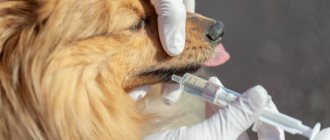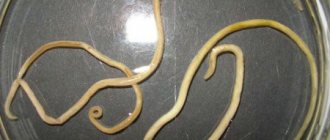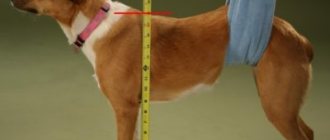Worms are parasitic worms that live, feed and reproduce in the donor's body. They enter the digestive tract, spread throughout the organs and do not manifest themselves for years. But all this time, great harm is done to the dog’s health. And communication with a pet can cause infection to humans and other pets.
Symptoms
Helminthiasis in dogs is sometimes asymptomatic or disguised as other diseases. But attentive owners can determine the presence of worms by the following signs:
- Developmental delay. Puppies grow poorly and are inactive. They have matte fur and a bluish rim to the whites of their eyes.
- Weight loss. With normal or increased appetite, the pet looks exhausted. His ribs stand out, but a hard, swollen belly can be felt.
- Eating disorders. Balls of worms prevent food from moving through the intestines. Sometimes after eating, hiccups, diarrhea, vomiting, and stomach rumbling appear.
- Impurities in feces. Pus, mucus, blood, parasites, larvae, and eggs are visible in vomit and feces. When attached to the anus, worms cause itching and a desire to scratch the butt on the floor.
- Breathing problems. A dog with lungworms or heartworms is breathing and coughing frequently. She is tormented by tachycardia and heart pain. The animal hides in a corner and refuses food.
Helminths absorb nutrients necessary for the dog's life. A deficiency of beneficial components is manifested by hair loss and changes in the color of the mucous membranes. The dog becomes lethargic, weak, and quickly gets tired on walks.
Signs of worms
The pathological condition develops when parasites multiply uncontrollably. The disease is characterized by the following symptoms:
- lethargy, the dog lies a lot;
- mucous membranes are pale;
- the coat is tousled, dull, dermatitis develops, and dandruff falls off;
- changeable appetite - gluttony alternates with refusal to eat;
- the dog eats inedible objects;
- digestion is upset, diarrhea is replaced by constipation;
- swallowing is difficult;
- the dog owner observes how whole worms or fragments come out with feces or vomit;
- tapeworm segments irritate the anus, the dog rides on it;
- puppies are stunted and look thin with a sagging belly.
The worms caused anal itching.
If your dog is constantly vomiting, watch it and find out when it was last dewormed. If you feel unwell, seek veterinary help.
Vomiting is a symptom of high infestation.
Types of helminths
Only a veterinarian can determine the type of worms in a puppy or dog. A diagnostic examination will allow you to find out what parasites live in your pet’s body.
Nematodes or roundworms
Roundworms are often found in dogs that pick up food on the ground or drink water from a puddle. Roundworms, pinworms and other nematodes have a thread-like shape with a round cross-section. Most often they are fixed in the gastrointestinal tract, but they can also parasitize in other organs of the animal.
Trematodes or flukes
Flatworms appear in a dog’s body after eating raw fish and seafood or drinking dirty water. The worms are leaf-shaped and have suckers for attachment to the walls of the organ. They parasitize in the intestines, liver, and bile ducts. Infection with trematodes can cause the development of liver cirrhosis, pancreatitis, and jaundice.
Cestodes or tapeworms
Tapeworms appear in dogs after accidentally ingesting fleas or other skin bloodsuckers. It is ectoparasites that are carriers of cestode larvae. Helminths grow and multiply in the intestines, attaching to its walls with suction cups. As a result, the gastrointestinal tract becomes clogged with worms, causing intoxication and exhaustion.
Intestinal
White, yellow and gray worms in a dog can live in various organs. Sometimes they travel through the circulatory system. But most often, parasites colonize the dog’s intestinal tract. There they can easily obtain nutrients for their development and growth. Without treatment, they clump into balls, causing obstruction in the intestines.
Pulmonary
All lungworms in puppies and dogs have a common developmental feature. The larvae of these helminths pierce the intestinal walls, enter the bloodstream and migrate through it until they enter the capillaries of the bronchi or alveoli. Oxygen activates their development and growth. Reaching 3–4 mm in length, they exit into the oral cavity with a cough, and then are swallowed again and enter the intestines.
Heartfelt
Heartworm and Dirofilaria immitis roundworms are heart parasites. They enter the pet's body through an insect bite in the form of larvae. Then they migrate through the circulatory system, staying in the ventricles of the heart, eyes, peritoneal tissues, and under the skin. Without treatment, heartworms or subcutaneous worms can cause death in dogs. Small ornamental breeds are especially sensitive to their effects.
When to contact a veterinarian
A small amount of maggots on the dog’s body can be removed by the owner himself by treating the affected area with one of the above mentioned products. However, for serious wounds, with severe intoxication of the body and elevated body temperature for more than a day, it is better to contact a veterinary clinic. The problem is probably more serious than you think, so it is worth conducting a comprehensive examination of your pet.
The doctor will thoroughly clean the affected areas and prescribe effective treatment to eliminate any worms remaining in the fur or skin (antiparasitic agents are used). The longer maggots remain on the pet’s body, the greater the likelihood of severe tissue damage and increased intoxication in the dog’s body. This is especially true for gadfly larvae, which remain invisible for a long time under the top layer of skin (they are removed surgically).
Routes of infection
Helminths enter the animal's body in various ways.
- From mother. A pregnant dog with round flatworms or tapeworms passes the larvae to the puppy during pregnancy.
- Through ectoparasites. Ticks, fleas and other bloodsuckers infect your pet when they bite. The dog can also accidentally swallow an insect.
- Through raw meat and fish. Without heat treatment or freezing, the eggs and larvae of worms remain viable in muscle tissue for a long time.
- Through the mud. Worm eggs are released in feces and remain in the soil, sand, garbage, and dirty water.
Pets who do not leave the apartment due to illness or young age can also become infected. Helminth eggs enter the house on the soles of the owner's outdoor shoes.
Preventive actions
Worms pose the greatest danger to young animals - puppies infected with parasites can die in 2-3 weeks. Therefore, preventive measures should be started as early as possible, without waiting for symptoms. Don't reassure yourself that the litter is kept sterile - all puppies can become infected in the womb, through her milk or directly.
The first dose of anthelmintic drug is given to puppies at three weeks of age. When choosing a product, pay attention to what age it is intended for. Only special medications for puppies are suitable; this should be indicated in the annotation for the medication. Liquid forms are preferable, since tablets are difficult to divide by weight and are difficult for children to eat.
Before deworming, weigh yourself - do not exceed the recommended dose. Repeated administration of the same drug is carried out 10 days before the first vaccination. You should not exceed the recommended volumes and frequency of deworming - these drugs have a strong toxic effect on animals. Your veterinarian will tell you how often to treat worms.
It is also mandatory to give anthelmintic drugs to females and males before breeding. Lactating animals need to treat their nipples to prevent infection of the offspring. For preventive purposes, anthelmintic drugs are prescribed twice a year to dogs fed industrial food. For animals receiving natural food – 4 times a year.
Prevention Tips:
- Do not let your animal wander on its own. Always be nearby and watch him during a walk so that the dog cannot drink water from a puddle or open reservoir, or eat garbage and excrement of other animals.
- Take preventive measures against lice and fleas, which are carriers of internal parasite eggs. Along with taking medications for worms, give medications for external parasites.
- Don't give your dogs raw fish, especially freshwater fish.
Treatment
The first treatment of puppies for any type of worms should be carried out at the age of three weeks. Babies, pregnant and lactating bitches, and elderly pets are extremely sensitive to toxins that are released after the parasites die. Therefore, to treat them, it is necessary to use special anti-worm medications for dogs. In addition, veterinarians recommend giving them a spoonful of Vaseline oil to quickly remove decay products.
Pills
The anthelmintic in tablet form is crushed and added to the pet’s food. After two weeks, the treatment is repeated. In this way, larvae and young worms are destroyed, which were protected by the egg shell at the time of the first administration of the medicine. Quality drugs include Milbemax, Drontsit, Alben, Bicheldon, Brovanol.
Suspensions
The advantage of this form of anthelmintic drug is the ease of measuring the dosage. In addition, suspensions often have a pleasant smell and taste for the pet. To treat worms, you need to take the suspension into a syringe, remove the needle and squeeze the medicine into the animal’s mouth. Veterinarians recommend the drugs Helmintal, Dironet, Dironet Junior, Dirofen, Prazitel.
Drops on the withers
Liquid deworming medications for dogs perform several functions. They destroy helminths in the animal’s body and ectoparasites on its fur. Drops are applied to the area between the shoulder blades so that the dog cannot lick off the medicine. The liquid is quickly absorbed through the pores of the skin into the bloodstream and destroys parasites. Quality products – Prazicide Complex, Inspector, Lawyer, Stronghold, Helmintal.
Traditional medicine
Folk remedies for worms for dogs only help get rid of intestinal parasites. Additionally, it is very difficult to calculate the dosage of a home remedy. A low concentration of the main substance will not be able to destroy helminths, but too high will harm the health of the pet. Medicinal plants with similar effects include tansy, celandine, wormwood, garlic, and pumpkin seeds.
How do lice get on a dog's body?
Lice-eaters get onto a dog's hairline through contact - through contact with other domestic animals affected by lice-eaters, especially often infection occurs through contact with stray dogs.
A dog can become infected with lice eaters through care and hygiene items - bedding, combs, etc. The ectoparasite can enter the apartment on the shoes and clothes of the owners and through household items.
Dogs most often at risk are those kept in groups in shelters, nurseries, and hotels when their owners fail to comply with existing animal hygiene standards and lack proper care.
Contributes to the disease of dogs with lice eaters and other ectoparasites:
- High humidity in enclosures and rooms for dogs.
- Weakened immunity in the animal, decreased body resistance.
- Presence of autoimmune diseases.
- Lack of preventive treatments of dog fur with insecticides.
Danger to humans
A dog or puppy with worms, when interacting with a person, can infect him with helminthiasis. The larvae and eggs of parasites leave the animal's body in the feces. They can attach to the pet's fur, bedding or toys, and then end up in the owner's hands.
Due to the difference in body temperature, not all dog worms can live in the human body. But some of them can cause dangerous diseases.
- Toxocara canis. The larvae migrate through the human circulatory system, settling in various organs. As a result, ocular or visceral toxocariasis develops. It affects the lungs, liver, eyes, and central nervous system.
- Echinococcus granulosus. The larvae of this helminth are extremely dangerous for the human body, although they cannot develop in it. They migrate throughout the body and settle in the lungs, forming a cyst. The neoplasm causes coughing and chest pain.
- Echinococcus multilocularis. The larvae of this tapeworm settle in the human liver and also form a cyst. When a secondary infection occurs, jaundice, abscess, and cirrhosis of the liver develop.
- Coenurus cerebralis. The larvae of such worms look like a water bubble. They settle in the area of the spinal cord or brain. Depending on the location of the lesion, a person suffers from migraines, seizures, and decreased vision.
- Dipylidium caninum. The tapeworm takes root in the human intestine, develops, grows, and reproduces. As a result, the patient suffers from diarrhea, skin rash, and abdominal pain.
Timely deworming and proper personal hygiene will help avoid the development of these diseases.
Morphological features
It all starts with the appearance of small swellings and thickening on the surface of the skin. At first, their size does not exceed 1x1 cm, but within a few weeks the area of the lesions increases two to three times. Most often, these tumors are found on the lower surface of the abdominal wall, closer to the genital area. Soon the seals soften somewhat, becoming similar in consistency to cysts . When they were surgically removed, the inside of the cysts was separated from the “main” tissue by a demarcation line of inflammation (but not always). In addition, a worm is found inside the tumors. The length of subcutaneous parasites does not exceed 12 cm , their body is thin, grayish-white in color.
Personal safety measures
Medicines for the destruction of worms contain a small concentration of poison or a paralyzing substance for parasites. Therefore, during deworming, observe personal safety measures. After handling any form of medication, wash your hands with soap and discard the product packaging.
Keep deworming medications out of the reach of children and animals. Do not use medicine that has expired or after darkening, cloudiness, or impurities have appeared. Do not use empty bottles for household purposes.
Prevention
It is known that the best treatment for any disease is its prevention! Therefore, to prevent infestation, it is optimal to worm an adult dog once every three months . However, we should not forget that all anthelmintic drugs are, in fact, toxic poisons. Therefore, when deworming, you should always be extremely careful and careful.
Small puppies can begin to be wormed as early as 12-14 days of their life . There are special “children’s” preparations for them, mainly in the form of suspensions, for example “Prasicide” or “Drontal plus for puppies”. Also mandatory after any deworming is vaccination of the animal, which consolidates the results of treatment.
As you can see, helminthiasis is a serious and dangerous disease. And in order for your four-legged friend to bring joy for as long as possible, it is necessary to show special care and attention to his health.











